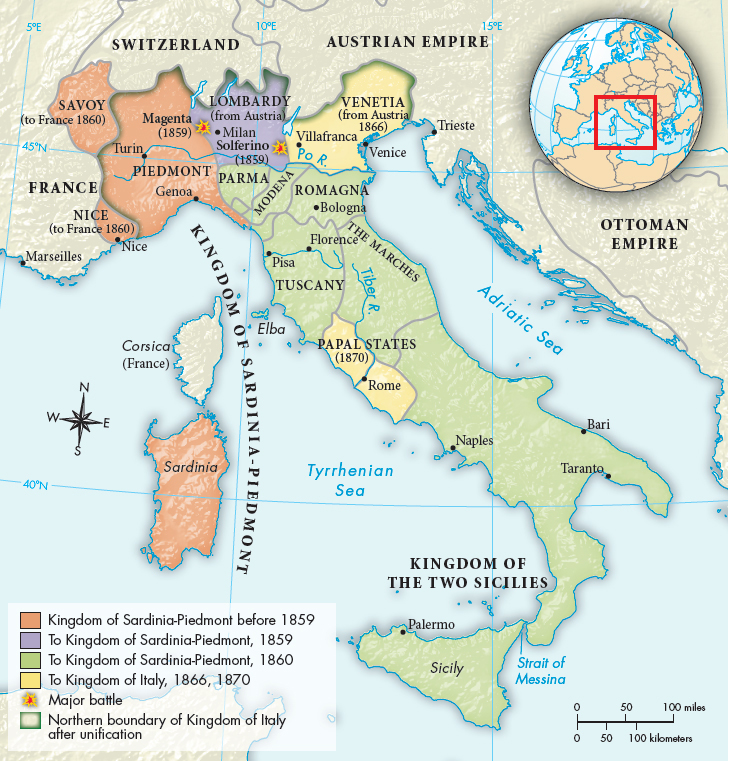A History of World Societies:
Printed Page 728
A History of World Societies Value
Edition: Printed Page 735
Cavour, Garibaldi, and the Unification of Italy
Italy had never been a united nation prior to 1850. A battleground for the Great Powers after 1494, Italy was reorganized in 1815 at the Congress of Vienna. Austria received the rich northern provinces of Lombardy and Venetia. Sardinia and Piedmont fell under the rule of an Italian monarch, and Tuscany shared north-

After 1815 the goal of a unified Italian nation captivated many Italians, but there was no agreement on how it could be achieved. In 1848 the idealistic nationalist Giuseppe Mazzini hailed efforts to form a democratic Italian republic. Like the other revolutions of 1848, Mazzini’s failed, crushed by Austrian forces. Temporarily driven from Rome during the upheavals of 1848, a frightened Pope Pius IX (pontificate 1846–
Sardinia had the good fortune of being led by Count Camillo Benso di Cavour. Cavour came from a noble family and embraced the economic doctrines and business activities associated with the prosperous middle class. Cavour’s national goals were limited and realistic. Until 1859 he sought unity only for the states of northern and perhaps central Italy in a greatly expanded kingdom of Sardinia.
In the 1850s Cavour worked to consolidate Sardinia as a liberal constitutional state capable of leading northern Italy. He worked out a secret diplomatic alliance with Napoleon III, and in July 1858 he goaded Austria into attacking Sardinia. The combined Franco-
Popular revolts and Italian nationalism salvaged Cavour’s plans. While the war against Austria raged in the north, dedicated nationalists in central Italy had risen and driven out their rulers. Nationalist fervor seized the urban masses, and the leaders of the nationalist movement called for fusion with Sardinia. Cavour returned to power in early 1860, and the people of central Italy voted overwhelmingly to join a greatly enlarged kingdom of Sardinia. Cavour had achieved his original goal of a north Italian state (see Map 24.2).
For superpatriots such as Giuseppe Garibaldi (1807–
Secretly supported by Cavour, Garibaldi conceived a bold plan to “liberate” the Kingdom of the Two Sicilies. Landing on the shores of Sicily in May 1860, Garibaldi’s guerrilla band captured the imagination of the Sicilian peasantry, which rose in rebellion. Outwitting the royal army, Garibaldi captured Palermo, crossed to the mainland, and prepared to attack Rome and the pope. But Cavour quickly sent Sardinian forces to occupy most of the Papal States (but not Rome) and to intercept Garibaldi. When Garibaldi and Victor Emmanuel rode through Naples to cheering crowds, they symbolically sealed the union of north and south, of monarch and people.
The new kingdom of Italy, which did not include Venice until 1866 or Rome until 1870, was a parliamentary monarchy under Victor Emmanuel, neither radical nor democratic. Only a small minority of Italian males could vote. Despite political unity, the propertied classes and the common people were divided. A great social and cultural gap separated the progressive industrializing north from the stagnant agrarian south.